Cuban Chests
A National Cigar Museum EXCLUSIVE
© Tony Hyman, All rights reserved
Last addition: May 2, 2012

Cuban Chests
A National Cigar Museum EXCLUSIVE
© Tony Hyman, All rights reserved
Last addition: May 2, 2012
When Europeans arrived in Cuba they discovered more than tobacco. Numerous fruits and veggies were added to the world’s tables. Exotic hardwoods were none the less prized. The island soon became known for fine woodworking, much of which went into creating chests for the island’s cigars so highly prized by the wealthy worldwide. All Cuban export cigar companies seem to have used fancy chests at one time or another.
H. Upmann c1955
A gift to me from one of my father’s friends who bought it new filled with cigars in the early 1950’s.
A large box, measuring 11” x 12” x 3.5” mas o menos, it is sectioned to hold five vitolas (sizes and shapes) made from “vintage 1952” tobacco.

Unknown cigar maker in the 1940’s for
Comision Nacional de Propaganda y Defensa del Tabaco Habano
Five of these lovely boxes decorated with the Cuban national emblem have appeared on eBay. None are marked with a cigar maker, suggesting these were intended as factory-made after-market humidors, perhaps for the tourist trade.
This example is the only one of them carved as having been used by the Comision Nacional de Propaganda y Defensa del Tabaco Habano, presumably as a gift or to hold give-away cigars at official displays.
Flor de Fonseca by F.E. Fonseca
Opening factories in New York City (at age 20) and Havana (4 years later), F.E. Fonseca (1868-1929) specialized in private brands. He was known as a tobacco expert and became a friend of politicos and other celebrities worldwide. Among smokers who commissioned him to make their private brands were Edward VII of England and Germany’s Kaiser Wilhelm. Can you decipher the stylized monogram? c1910
Nee incorrectly reports Fonseca dying in 1930.
I own his 1929 obituary.
La Española de Fueyo y Ca.
Little is known about this brand or the reason for this stunning 16” carved chest with its art nouveau woman design. The monogram is unidentified.
Rotary Convention gift by El Rey del Mundo 1928
Particulares de Segundo Lopez y Ca. c1900
Lovely rose inlay on a book shaped box of a brand and maker I know little about. Information is welcome.
Derecho Internacional de T.D.L. c1900
La Escepcion de Jose Gener 1870’s
One of Cuba’s more important 19th century brands packed in a gorgeous serpentine chest in Chippendale style. The brand was created in the 1850’s by Jose Gener y Batet and has been a ‘sister’ brand to HOYO DE MONTERREY. c1875
H de Cabañas y Carbajal 1850’s
Wooden box with heavy black paint? with gold trim, probably stenciled.
Apparently made for the general trade, but held high quality expensive cigars. c1850.
This brand was registered officially in 1810, though some reports says it was in business in the 1790’s. In 1848 the brand obtained its present name. H refers to Hija (daughter).
The brand was purchased by the Tobacco Trust, then resold in 1932 to Tabacalera Cubana.
President Batista chest by H. Upmann
Batista did make an effort to improve conditions for Cubans other than himself, sponsoring welfare laws, public works improvements, pensions and insurance for government workers, minimum wage laws, rural schools and other reforms, personally pocketing only a “reasonable share” of the various earmarked funds.
Rather than hold an election in 1952, Batista declared himself President in violation of the Cuban Constitution. He pledged order, stability and no more labor unrest, music to the ears of the U.S. government and businessmen as well as most Cubans. So cynical had the Cuban population become about its own government, that there was little opposition when Batista simply took over, promising to hold free elections again, some time down the road. Cuba’s last President before Castro’s revolution, Batista smoked cigars by H. Upmann, founded in 1844.
President Menocal chest by Punch
President Gomez chest by Hoyo de Monterrey
This exquisite chest was custom made for him with cigars by HOYO de MONTERREY.
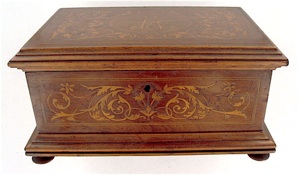
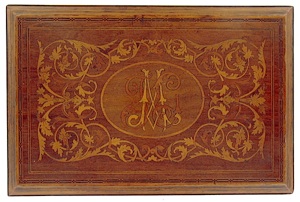
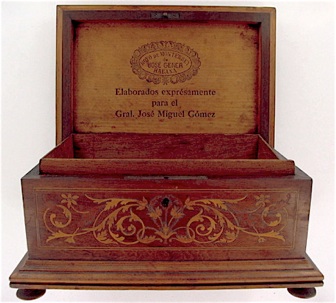
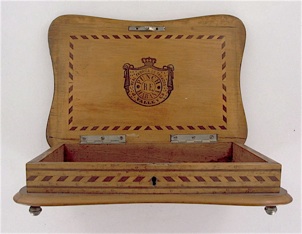
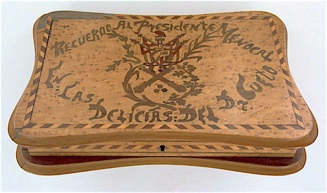
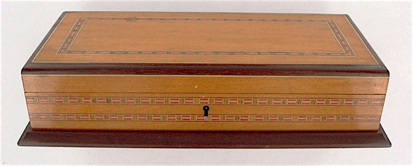
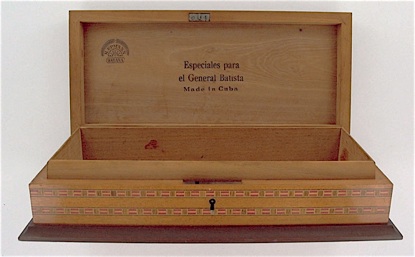
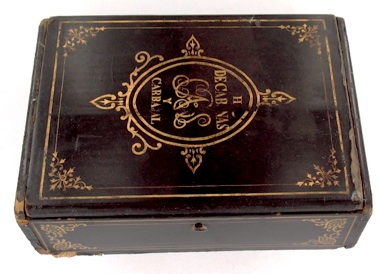
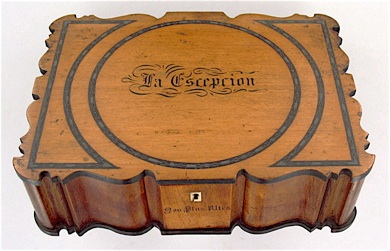
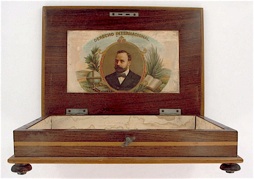
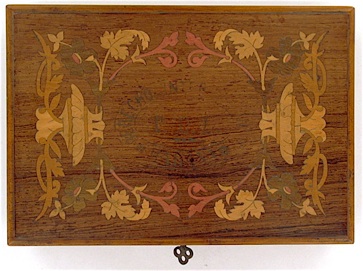
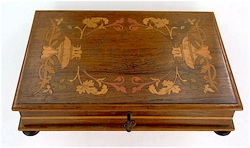
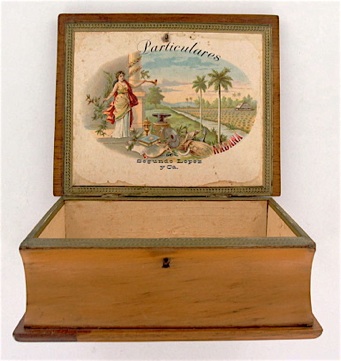
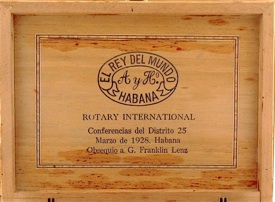
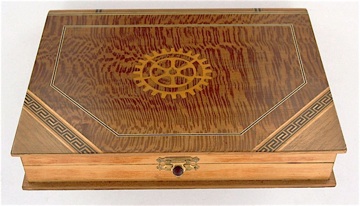
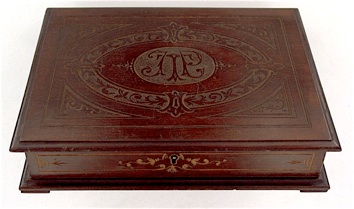
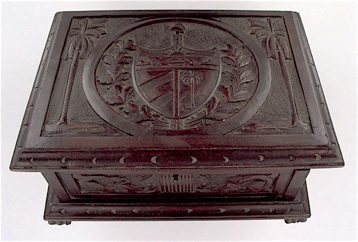
La Corona cabinet 1903
This LA CORONA 5,000 cigar cabinet was ordered from Cuba by a Buffalo, NY, tobacconist in 1903. I bought it from his descendants 80 some years later. Cigars were bundled in ruedas (wheels) of 25 and stood on end.
Photo by Tom Somerville.

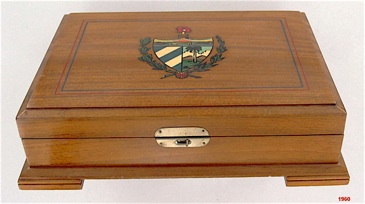
Unidentified Cuban cigar company 1919
Gesso-covered and painted box used for
an assortment of different frontmarks by an unidentified Cuban cigar maker in 1919. Box measures 10” x 12” and less than 2” thick.
C.E. Beck y Ca. 1915
C.E. Beck was one of the independent Cuban makers in the early days of “free” Cuba. This large reusable attache case measures 10” x 15.5” and is very rare.
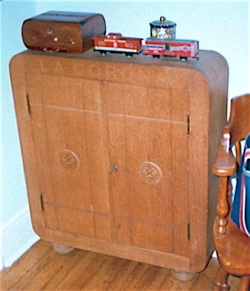
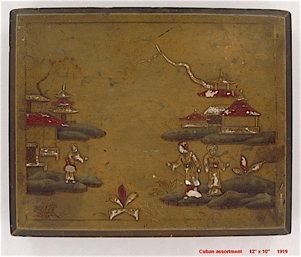
Jose Piedra billiard table
Great box of 50 cigars under a billiard table.
Date unknown. Piedra’s logo changed little over the years so is little help.
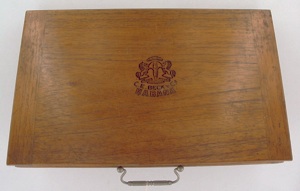
Jose Piedra “mechanical” gem
Unusual ‘mechanical’ which coverts cigars laying flat into uprights. Boxes that have pivots or hinges other than the lid are called mechanicals.
Date unknown but believed to be relatively new compared to other boxes in this exhibit.
SOLD
Unidentified Cuban cigar maker 1920’s
During the 1920’s the card game of bridge became a national fad. An unidentified Cuban cigar company responded with a Craftsman style table box complete with 50 cigars, two different scoring charts, and a place for a deck of cards.
Unidentified Cuban cigar maker c1900
Certainly not a chest or cabinet, but an irresistible Cuban novelty.
Boxes designed to be used for another purpose after emptied are called, logically, “reusables.”
This photo album box was made in bright blue as well as green and brown. At least two different labels are known, tho both are decorated with lace. Stains in the inner liner indicate that 12 cigars were packed in the box.
Using lace for decorating goes back at least as far as the 1870’s in the U.S., perhaps earlier in Cuba. At some future date, I hope to put up an exhibit of various uses of lace in cigar boxes.
Por Larrañaga tobacco bale 1906
Distinctive limited edition tobacco bale box used by Por Larrañaga just after the turn of the century. Measures 7” x 7.5” x 4.5” and has a relatively plain Larrañaga paper label inside.
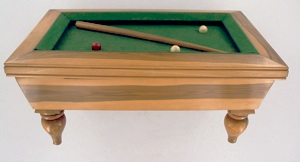
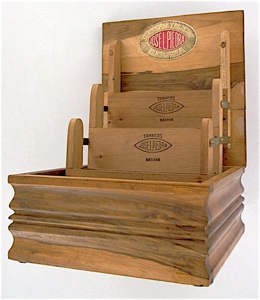
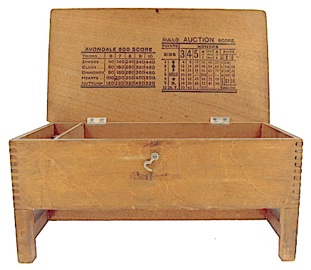
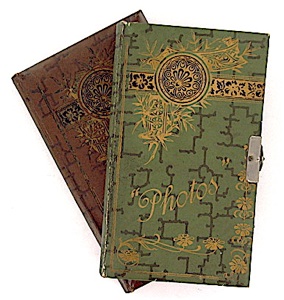
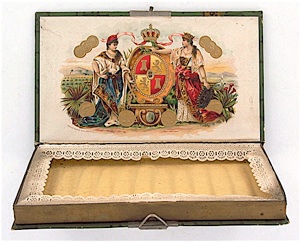
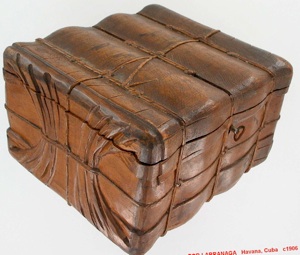
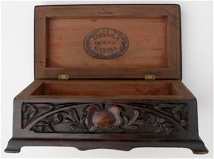
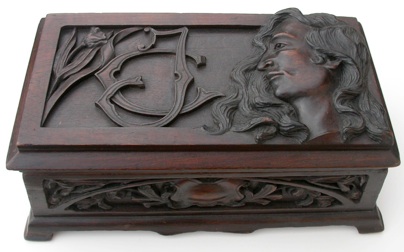
Cohiba bohio
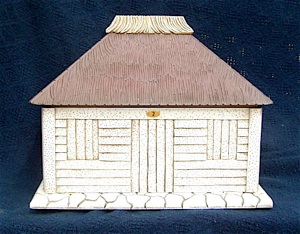
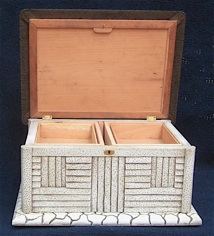
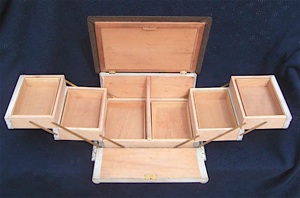
El Aguila del Oro de Bock y Cia. 1880’s
Another of Cuba’s more impor-tant brands, it was purchased by the Tobacco Trust in the early 1900s and ultimately moved to New Jersey in the 1930’s. Bock is frequently credited with introducing the idea of cigar bands on Cuban cigars to fight widespread counterfeiting in Europe.
This unusual chest with its lovely cabinetry held only ten, most likely very expensive, cigars.
Romeo y Julieta de Alvarez y Garcia c1900
Another of Cuba’s more important and long lasting export brands was registered in 1873, though believed by some scholars to date back to the 1850s. The Frontmark on this stunning bird-covered chest is Seleccion No. 3.
This beautiful box is believed to date shortly before the brand was sold to the Tobacco Trust in 1903.
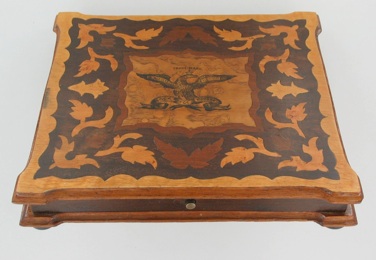
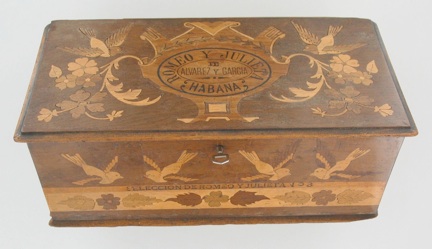
Por Larrañaga cabinet early 1900’s
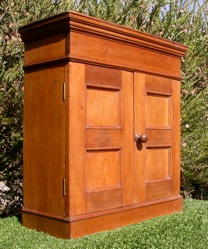
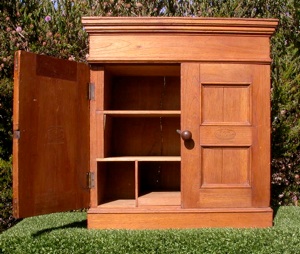
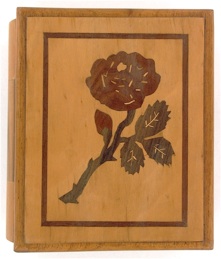
Magazine ad depictions of full cabinets 1910±
[Color ad not in NCM]
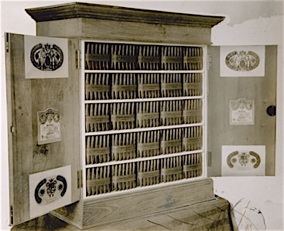

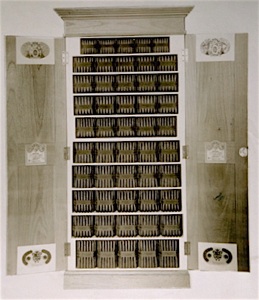
Jose Piedra chest
Established in 1880, the Jose Piedra brand was once the best known Cuban cigar outside Havana. Very popular in the U.S. right up until the embargo, the brand was discontinued, then reintroduced in Cuba. Cigars, these included, were made of Remedios tobacco in the Camajuani area of Cuba. The inlaid name on top is Elda Gils; the inside metal plate has the name Dr. Rafael Angulo.
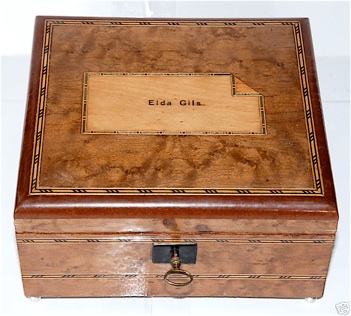
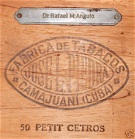
Personalized chests
Mike Todd is congratulated by H. Upmann on the 1st anniversary of his movie “Around the World in 80 Days” with a giant person-alized box of, what else, H. Upmann cigars.
[11682]

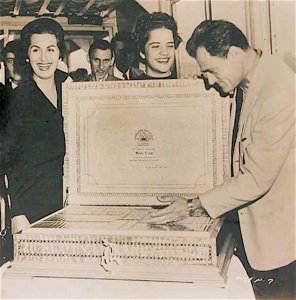
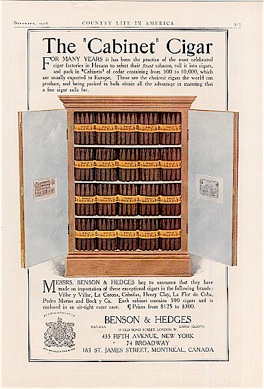

H de Cabañas y Carbajal c1905
Legend has Don Francisco Cabañas making cigars in the 1790‘s. What we know for certain is that he was the second person to list his brand when registration began in 1810 Cuba.
In 1848 the brand was reregistered as Hija (daughter) of Cabañas y Carbajal after the two families merged. Not long after, Hija became simply H.
The label evolved over time, this version first appearing around 1900 when the brand was acquired by the Tobacco Trust. See the exhibit of classic Cuban boxes for the earlier style label.
This exquisite box is not in the NCM collection, alas.



El Aguila del Oro de Bock y Cia. 1880’s
El Aguila del Oro (The Golden Eagle) was known around the world, though most smokers, including yours truly, asked for a “Bock” when laying our money on the counter.
This exquisite 13 ½” octagonal assortment contained only eight of the nearly 100 sizes and shapes of cigar offered by that company at or before the turn-of-the-century. Once the brand was taken over by Duke’s Tobacco Trust, the use of fancy inlaid expensive-to-manufacture boxes was sharply curtailed.
Boxes like this were intended as gifts, not salesmen’s samples.
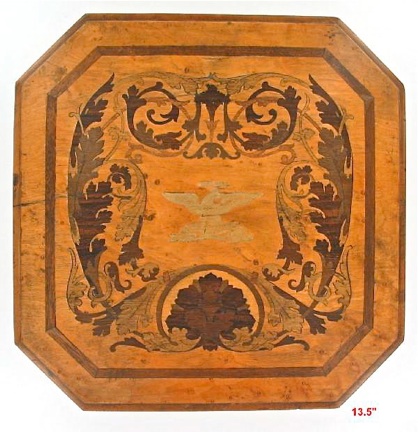
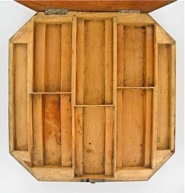
[16266]
[16267]
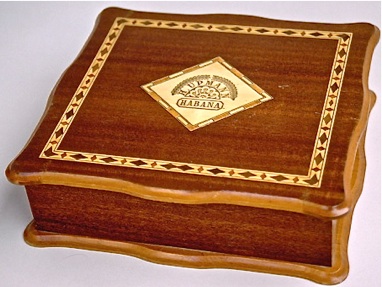
A de Villar y Villar, early 1890s
Museum visitor Noel Pelavin sent these photos of his Cuban chest from the early 1890s, datable as the inside contains a sticker noting the cigars were made from the tobacco crop of 1887. Five years or longer of curing leaf then aging finished cigars typically passed between harvest and offering cigars to the world’s smokers.
The brand is one of many gobbled up by the Tobacco Trust and ultimately moved to New Jersey, where it was still being made in the 1950s
using the same fine b/w inner label.
[DSC05759] [DSC05720]